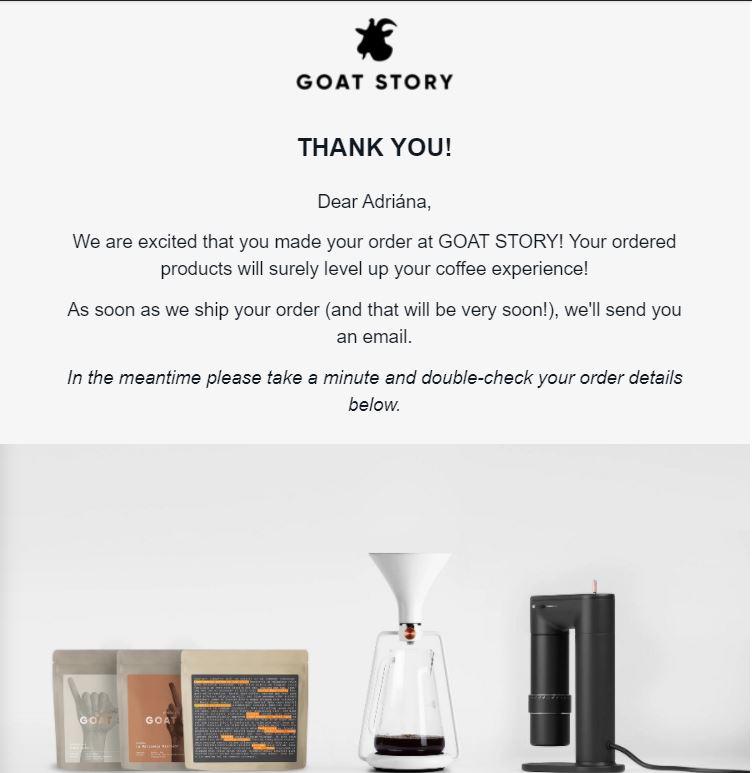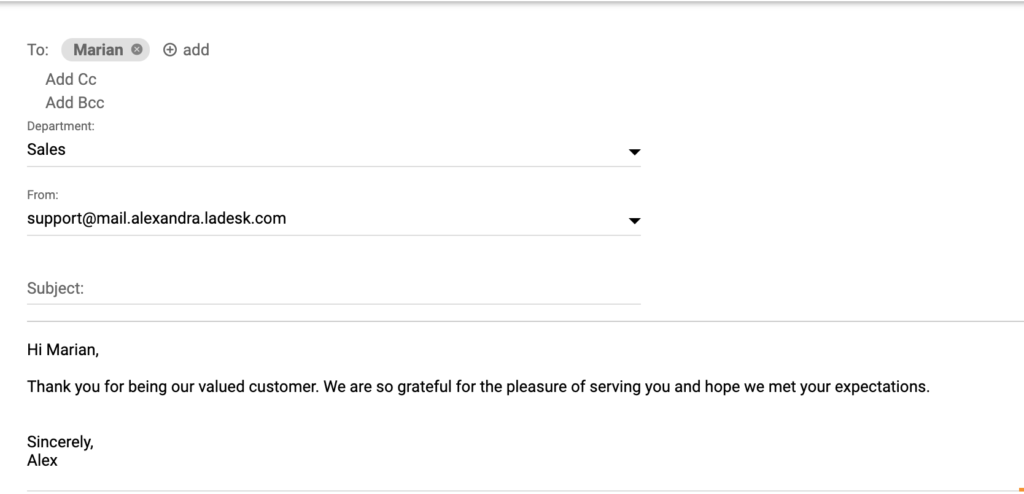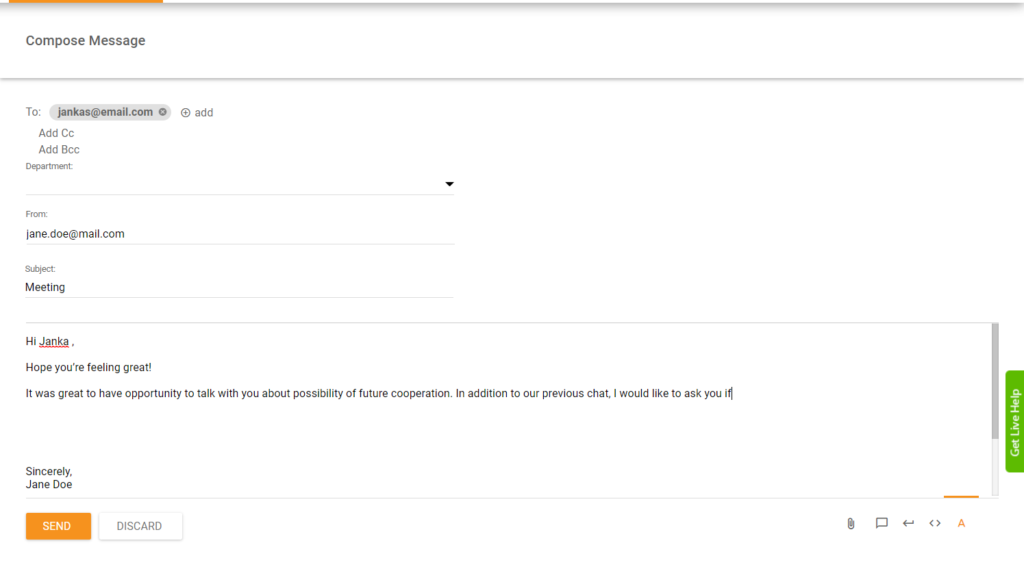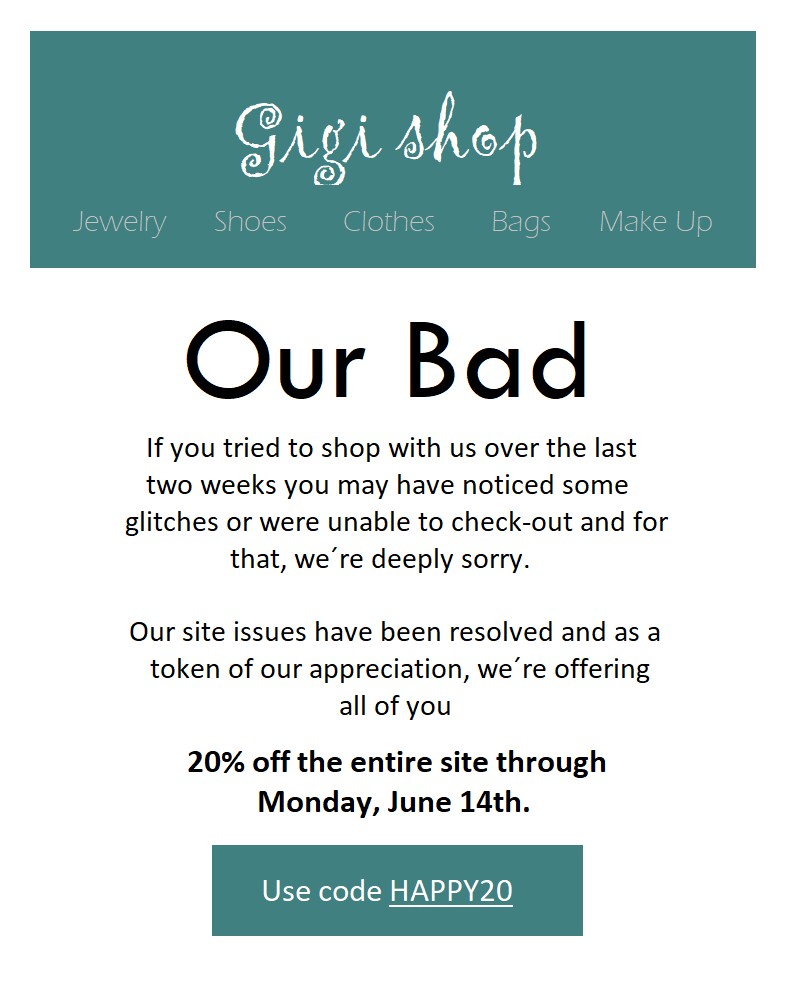- Email sjablonen
- Hoe een email te starten (Tips + sjablonen)
Hoe een email te starten (Tips + sjablonen)
Leer hoe je een professionele e-mail start met tips en sjablonen. Kies de beste aanhef en ontdek wat je aan het begin van je e-mail moet vermelden. Inclusief sjablonen voor verschillende soorten e-mails zoals welkomst- en klantenservice-e-mails.

Met meer dan 300 miljard emails die elke dag worden verzonden en ontvangen, is email een essentieel communicatiemiddel. Het bedenken van een professionele manier om een zakelijke email te beginnen – vooral wanneer u schrijft naar iemand die u niet kent – kan een uitdaging zijn voor marketeers, verkopers en klantenondersteuningsmedewerkers.
In feite kan de manier waarop u uw email start het verschil maken tussen het feit of de ontvanger de email meteen sluit (en verwijdert) of verder leest. Het volgende artikel bevat enkele tips voor het starten van een email, samen met enkele van de meest voorkomende emailbegroetingen en emailstarters die u kunt gebruiken in uw zakelijke correspondentie. Van transitie-emails naar netwerkemails kan het een zegen zijn om over het juiste sjabloon te beschikken. We helpen u ook als u sjablonen voor zakelijke emaildoeleinden nodig heeft.

Wat moet u aan het begin van uw emails vermelden
1. Aanhef of groet
Begin met een passende begroeting, afhankelijk van hoe formeel je moet zijn. Vermeld altijd de naam van de ontvanger (als u die weet) om de begroeting persoonlijker te maken. Last but not least, controleer nogmaals of je de naam van de ontvanger correct hebt gespeld. Onze pro-tip? Kopieer en plak hun naam zoals te zien is in eerdere emails, emailhandtekeningen of websites om ervoor te zorgen dat u geen typefout maakt.
2. Inleiding en reden van schrijven (indien nodig)
Wanneer u voor de eerste keer naar iemand schrijft, stel uzelf dan voor en voeg een beknopte zin toe over het doel van uw email. Deze zin kan bepalen of de ontvanger uw email zal lezen of negeren, dus zorg ervoor dat uw doel duidelijk en overtuigend is.
Als u gemeenschappelijke vrienden, collega’s of kennissen hebt, vermeld deze dan, omdat dit uw kansen op een reactie kan vergroten. U kunt bijvoorbeeld een subtiele naamval als volgt doen: “Hallo [Naam], ik kwam onze wederzijdse vriend Richard (van [Bedrijf]) in het weekend tegen en hij zei dat u een nieuwe helpdesktool nodig had, omdat uw huidige provider het gewoon niet meer redt…”
3. Een openingszin/goede wensen (optioneel)
Als u de ontvanger lange tijd niet hebt geschreven of als u een informele relatie met de ontvanger hebt, zou het gepast zijn om een snelle, positieve opmerking op te nemen, zoals “Ik hoop dat het goed met u gaat.” Dit kan de juiste toon zetten voor de rest van uw email.
Als alternatief, als de ontvanger updates heeft gedeeld op LinkedIn of andere sociale media, kunt u hem of haar feliciteren met hun laatste prestaties (zowel persoonlijk als professioneel). U zou iets kunnen zeggen als “Gefeliciteerd met uw promotie” of “Gefeliciteerd, het is geweldig om te zien dat [Bedrijf van de ontvanger] zo’n belangrijke klant als [Bedrijf] binnenhaalt.”
4. Een bedankje (optioneel)
Op basis van de context kunt u een korte bedankregel toevoegen aan uw emailcorrespondentie. Als uw potentiële klant/klant bijvoorbeeld contact met u heeft opgenomen met een vraag, is “Bedankt voor het contact” of “Bedankt voor het contact opnemen met [Bedrijf]” een must- hebben. Wanneer je een bedankbriefje plaatst, is het echter belangrijk om het persoonlijk te maken, aangezien standaard bedankbriefjes (zoals de hierboven genoemde) een beetje te algemeen zijn en koud of afstandelijk kunnen overkomen.
Door simpelweg een naam toe te voegen voor uw bedankregel, klinkt het bericht warmer en uitnodigend. Hier is een voorbeeld: “Emily, hartelijk dank voor het contacteren van [Bedrijf] en voor het aankaarten van dit probleem. Uw hebt helemaal gelijk…”

Voorbeelden en sjablonen om een email te starten
Professionele emailgroeten
‘Hallo [Naam]’ is waarschijnlijk de meest voorkomende en meest gebruikte emailaanhef in de zakenwereld. Deze begroeting wordt over het algemeen aanbevolen voor semi-formele en informele communicatiestijlen. Als u iets formeler wilt zijn, kan ‘Hallo’ worden vervangen door ‘Dag’
“Beste [Naam]” is ook geschikt voor zowel formele als informele communicatie. Voor uw gemak hebben we een hele lijst met andere algemene begroetingen opgesteld waaruit u kunt kiezen bij het starten van uw professionele email. Bekijk ze eens:
Bij het schrijven naar een of twee ontvangers:
- Beste [Naam],
- Beste [Naam] en [Naam],
- Hallo [Naam],
- Hoi [Naam],
- [Naam],
- Hey [Naam],
Bij het schrijven naar drie of meer ontvangers:
- Hallo iedereen,
- [Group of teamnaam],
- Hoi team,
- Hallo allemaal,
- Hoi daar,
- Goedemorgen,
- Goedemiddag,
- Goedenavond,
Als u niet zeker bent van de naam van de ontvanger:
- Geachte heer,
- Geachte mevrouw,
- Hoi,
- Hallo,
- Gegroet,
- Geachte Recruteringsmanager,
- Beste Recruteringsteam,
Algemene openingszinnen voor email
Na de begroeting kunt u een korte openingszin opnemen om uw email een vliegende start te geven. Het is echter het beste om zinnen als deze te vermijden als u een formele email schrijft of een potentiële klant een koude email stuurt, aangezien ze te vriendelijk kunnen overkomen. U moet ook op uw hoede zijn voor de toon die u gebruikt in bijvoorbeeld een verontschuldigingsbrief van een bedrijf. Hier zijn enkele van de meest voorkomende voorbeelden van emailopeners:
Hope this email finds you well.
I trust you are doing well.
How’s it going at [Company name]?
It’s great to hear from you.
I’m pleased to hear that…
I hope you enjoyed your weekend.
Hope you’re enjoying your holiday.
I hope you had a great trip.
I hope you’re doing well.
Hope you’re feeling great!
I hope you’re having a great week.
I hope you’re having a wonderful day.
I hope you enjoyed the event.
I hope you enjoyed your vacation.
I’m reaching out about…
I’m wanted to ask about…
I just wanted to send you a brief note about …
Congratulations on [recent accomplishment].
How did [recent project/ event] turn out?
I loved your recent [article/social media post].

Vervolg email openingszinnen
Als u niet zeker weet wat u aan het begin van uw vervolgmail moet schrijven, overweeg dan om een van de volgende openingszinnen voor emails op te nemen die het ijs kunnen breken:
As we discussed in our phone call …
As we discussed at our meeting …
As promised, here’s …
I’m checking in on …
Just checking in to make sure that …
Following up on our meeting …
I am writing to follow up on…
I’m getting back to you about…
This is just a quick note to…
This is just a quick reminder…
I wanted to let you know that…
Can you please give me an update on …
I’m writing to remind you about…
It was great to meet you at [event].
It was great talking to you last week.
I’m glad we had a chance to chat at the [event].
It was a pleasure to meet you yesterday.
Antwoord email openingszinnen
Bij het beantwoorden van een klant of een prospect is in veel gevallen een korte bedankregel gepast. Als u niet zeker weet hoe u een “Bedankt” moet gebruiken of wat meer inspiratie nodig hebt, bekijk dan enkele van onze alternatieven:
Thanks for getting in touch.
Thank you for your message.
Thank you for letting me know.
Thank you for the update.
Thank you for the heads up.
Thanks for keeping me in the loop.
Thanks for the quick response.
Thank you for taking the time to [write to us/give us your feedback].
Thank you so much for getting back to me.
Thanks for getting back to me so quickly.
Thanks for your feedback on …
I’m sorry it took me so long to get back to you.
I apologize for the late response.
I’m sorry it’s been so long since my last email.
Sorry for my late reply.
Could you please clarify [something]?
Could you explain what you mean by [something]?
Could you give us some more details on…?
Hoe een koude verkoopsemail te starten
Bij het schrijven van een koude email aan een prospect, bepaalt de eerste alinea of uw prospect uw bericht de moeite waard vindt om te lezen, dus het is belangrijk om indruk te maken en op te vallen. Hier zijn enkele voorbeelden van wat u in uw inleidende paragraaf kunt opnemen:
“My name is [Name], and I am the marketing director for [Company]. [Mutual connection] recommended that I get in touch with you regarding …”
“My name is [Name], and I’ll keep this quick. I’m the founder of a software tool that helps businesses like yours achieve [specific goals] through [product benefits].”
“My name is [Name] and we work with companies like [Company 1], [Company 2], and [Company 3] to improve their [sales/ marketing efforts/ customer service, etc.].”
“[Name] from [Company] here. I saw you recently [visited our website/ downloaded a whitepaper, etc.]. I’ve worked with similar companies in [field/ industry] and I thought I’d reach out.”
“My name is [Name] and I’m with [Company]. We have recently launched a new solution that [what your solution does]. Based on your online profile [profile link], it appears that you might be the right person to talk about [problem solved by your product].”
Als u meer wilt weten, bekijk dan sjablonen voor koude verkoopemail.
Hoe start u een vervolgemail voor de verkoop?
Het opvolgen van een prospect, vooral als ze niet hebben gereageerd op uw vorige bericht(en), kan lastig zijn. Als dat het geval is, probeer dan een van deze effectieve openingszinnen voor emails – ze kunnen nuttig zijn!
“I trust that you have had an opportunity to read my previous email and look at our website, so I figured it’d be worth checking in with you again.”
“I sent you an email a while ago about [Company] and how I think we could be a great fit for you and [Company]. Did you know that our clients report [a **% increase] in [sales] when they use our [software/ platform/ tool]?”
“I hope I’m not overstepping, but I see that you have read my previous email and visited our site (the wonders of modern technology). I think this will be a good time for us to take the conversation further. What do you think? Are you available for a quick call on [date and time]?”
“I know how busy you must be managing your team and helping them increase [job function]. I sent you some information about [Product] a while ago and I thought this might be a good time to give you a practical demonstration.”
“I’m writing to follow up on my email as I didn’t hear back from anyone on the team. As I stated in my previous message, I believe [Product] can greatly improve how you do [what your product helps with].”
Als u meer wilt weten, bekijk dan sjablonen voor follow-up-email voor verkoop.
Design your own templates
LiveAgent gives you the power to design your own customer email templates, thus helping you to improve the customer service. Curious about all the opportunities?
Een welkomstemail na aankoop/klant starten?
Telkens wanneer iemand uw product koopt of zich aanmeldt voor uw service, moet u hen bedanken of welkom heten bij de ‘familie’ om ervoor te zorgen dat uw relatie goed begint. De beste manier om dit te doen is door een welkomstmail te schrijven met een bedankbriefje, een korte introductie en alle nuttige informatie.
“Thank you for your recent purchase with us! I hope you’re enjoying your [product/ service].”
“Welcome to [Company]! We’re feeling pretty lucky that you chose us, and I just wanted to say thank you on behalf of our whole company.”
“I’m [Name], the founder of [Company] and I’d like to personally thank you for signing up for our service.”
“Welcome to [Product/ Company]. We’re thrilled to see you here! I’ll be your guide during this onboarding period, and my goal is to ensure you have a positive experience and get the most out of our [product/service].”
“Welcome to [Brand]! We’re excited to have you on board and we can’t wait for you to start using [product/ service] and seeing results.”
Voel u vrij om meer emailsjablonen na aankoop en welkomstmailsjablonen te bekijken .
Hoe een klantenservice email te starten
Bijna elke klantenservice-email zou moeten beginnen met een ‘Bedankt’-bericht, of het nu gaat om het beantwoorden van een eenvoudig klantenserviceverzoek of het beantwoorden van een klacht van een klant. Hier is hoe het eruit kan zien:
“Thanks for reaching out! I’d be more than happy to help you.”
“Thank you for contacting [Company]. My name is [Name] and it would be my pleasure to assist you with …”
“Thank you for writing to us today. I’d be happy to answer those questions for you …”
“Thank you for your inquiry about […]. I’m really sorry to hear that you can’t […] I’m escalating your issue so that someone can take a closer look at what’s going on right away.…”
“Thank you for writing in. This message is to confirm that we’ve received your request, and will be in touch within ** hours with a complete response.”
Als u meer wilt weten, bekijk dan klantenservicesjablonen.
Een email met excuses voor klanten starten
Als u reageert op boze of ontevreden klanten, zorg er dan voor dat u empathie toont en een verontschuldigende email namens uw bedrijf stuurt. Hier is hoe u dat kunt doen:
“Thanks so much for reaching out about order #[number]. I’m so sorry the product hasn’t worked out for you.”
“I’m so sorry that you had a negative experience with [product/ service/ company department]. I’ve looked into the issue, and it seems that [briefly explain the reason for their bad experience].”
“I am so sorry to hear that you have had such a poor experience with us. Although we strive for 100% customer satisfaction, it’s clear we’ve fallen short in this instance – and that’s unacceptable.”
“I am so sorry to hear that [a brief summary of their bad experience]. That should have never happened, and I completely understand how frustrating this must be for you.”
“Thank you for providing us this feedback. I realize how frustrating it must be to [details of the issue]. We obviously failed this time, and for that, we are very sorry.”


LiveAgent combineert uitstekende live chat, ticketing en automatisering waarmee we uitzonderlijke ondersteuning bieden aan onze klanten.
Bekijk hoe u emails schrijft in het Engels – Formeel, Semi-formeel of Informeel.
hi everybody and welcome back to english. for professionals i'm derek and i'm here. with another short lesson for you busy. people in this business english emails. lesson i'm going to show you the. differences between formal. semi-formal and informal emails. [Music]. before we get started if you need. english for work and you're interested. in short lessons to help you with your. business english then subscribe to my. channel now hit the red button and don't. forget to click on the little bell that. way you'll be notified every time i. upload a new lesson and now. let's get started. we're going to do three things in this. lesson. first of all we'll talk about the. different kinds of people we write. emails to and we'll categorize them into. formal semi-formal and informal after. that i'll show you example emails in. each style and at the end of the lesson. i'll show you lots of extra example. phrases in each style. let's start with formal emails we. usually use a formal style when we write. to new customers suppliers and business. partners and also to people who are in. higher positions managers bosses and. directors. we usually use a semi-formal style with. colleagues we know but not very well and. also with existing customers suppliers. and business partners. we use an informal style when we write. to friends and family and also to. colleagues or business partners we know. very well and work with on a regular. basis. the most common style to use in business. is the semi-formal style but of course. there are exceptions. for example it's quite possible that we. could use an informal style to write to. a customer or a supplier but only if we. know that person very well and if we. have a good and long relationship with. them and one more thing the style you. use also depends on the culture in your. company as well as the business culture. in the countries you work within so you. need to be aware of those factors. and now it's time to look at some. examples we'll start with the formal. style and the email we're going to look. at is a follow-up email after a formal. business meeting with a potential new. business partner. we start with a formal greeting dear. miss amir. first of all i would like to thank you. for the productive meeting on monday it. was lovely to meet you and learn more. about your business here we have formal. phrases like i would like to and it was. lovely to meet you. as discussed in the meeting i am sending. you the additional information about. that you requested i have attached a. document with all of the details and. here we have more examples of very. formal phrases as discussed in the. meeting. that you requested and so on if you. require any further information please. do not hesitate to contact me again a. typical formal style. i look forward to our next meeting on. january 10th. best regards derek callum. i look forward to and best regards our. typical phrases we use to close a formal. email. so there we have the formal style now. let's compare that one to a semi-formal. version of the same kind of email. in this case it's a follow-up email. after a less formal meeting with a. potential new business partner and as. you'll see in a moment we're already. using first names. dear nidra first of all i just wanted to. say thanks for the productive meeting on. monday it was great to meet you and find. out more about your business so here you. can already see a big difference first. of all first names so imagine that first. meeting was less formal and by the end. of the meeting we were using first names. also in that first line we don't have. the i would like to we have i just. wanted to say. and also rather than saying it was. lovely to meet you and learn more about. your business we have the less formal it. was great to meet you and find out more. about your business. i've attached a document with the extra. information about. that you asked for here we see more. examples of a less formal style instead. of i have attached we use the short form. i've attached we don't use words like. additional information or that you. requested we use less formal style extra. information. that you asked for. and now let's look at the last part of. the email please let me know if you need. any more information looking forward to. our next meeting on january 10th regards. derek so again much less formal. please let me know instead of the very. formal please do not hesitate to contact. me if you need any more information. instead of if you require any further. information and also in the closing part. looking forward to instead of i look. forward to. and then we have regards which is. slightly less formal than best regards. so there we can see the differences. between the very formal and the. semi-formal. and as i said before the semi-formal is. the one we use most often in business. correspondence but of course as i said. earlier it always depends on who you're. writing to company culture the business. culture those are things you need to be. aware of. now let's take a look at the comparison. between the semi-formal and the informal. style. this time we have another follow-up. email but it's after a very informal. meeting with a colleague you know very. well. hi tom just a quick mail to say thanks. for the meeting on monday and to send on. that extra info you asked for. see attachment. the first difference we can see here is. in the greeting hi tom hi is less formal. than. deer and then also in the start of that. first sentence just a quick mail to say. this is a typical way to start an. informal email. when you're giving someone information. and then we also have phrases like to. send on that extra info very informal. let's continue if you need anything else. just get in touch so again very formal. expression here just get in touch. see you at the next meeting cheers derek. so typical way to end an informal email. see you at the next meeting. cheers cheers can mean goodbye it can. also mean thank you this is just one. possibility if you want to see more ways. to end an informal email check out my. other lesson. 17 ways to end an email. now it's time for the last part of the. lesson where i show you more examples of. typical email phrases for formal. semi-formal and informal emails. let's start with friendly openings it's. often a good idea to use one of these. after you're greeting and before you say. why you are writing. i hope everything is going well. semi-formal. i hope all's well. and in the informal version. hope all's well or nothing we don't. always need to include a friendly. opening especially to people who we are. writing to on a daily basis or who we. write to. very often. and now an example for saying why you. are writing. i am writing to update you on. semi-formal i just wanted to update you. on. and in the informal version. just wanted to keep you in the loop on. keep you in the loop is a very informal. phrase which means to keep somebody. informed about the latest information. about something. requests. formal style. would it be possible too. semi-formal. is there any chance you can. and the informal can you. making arrangements. i was wondering if you would be. available for a meeting next. semi-formal would you be available for a. meeting next. and informal. can we meet next. confirming arrangements i would like to. confirm our meeting. just want to confirm our meeting. i'll be there. giving information i am afraid i will. not be able to. i'm afraid i won't be able to. and sorry but i won't make it to. and one more example closing line. referring to next contact. i look forward to hearing from you soon. looking forward to hearing from you soon. and. talk to you soon. so that brings us to the end of another. short lesson i hope you liked it and i. hope you found it helpful don't forget. to check out all of my other email. lessons here on youtube. i'll leave a link in the description if. you did like the lesson hit the like. button and share with your friends and. colleagues subscribe to my channel if. you haven't done that and don't forget. to join my email list every two weeks i. send out my free vocabulary email with. additional business english words in the. news and everyday english for you to. learn the link is also in the. description below thanks a lot for. watching and talk to you soon.
Samenvatting
Het begin van uw zakelijke email (de begroeting, de openingszin en de eerste zin) is het eerste wat de ontvanger ziet wanneer ze uw email openen. Door uw email op een professionele manier te starten, is de kans groter dat u een positieve indruk op hen maakt. De begroeting die u gebruikt en de eerste paar zinnen die u kiest voor de start van uw professionele zakelijke emails, zijn afhankelijk van uw doelgroep en de context van uw communicatie. Gebruik de hierboven genoemde emailbegroetingen en emailopeningszinnen als prompts wanneer u niet zeker weet hoe u uw volgende email aan een klant of een koude prospect moet beginnen.
Vergeet niet om uw emails dubbel te controleren op spel- of grammaticale fouten en zorg ervoor dat u de naam van de ontvanger altijd correct spelt. Onze laatste tip is om het kort en krachtig te houden, want niemand wil lange emails lezen. Kom snel ter zake met de juiste tone of voice, en u bent goud waard.
Master the art of starting emails with LiveAgent's how-to-start-an-email templates.
Our expertly crafted templates provide you with effective and attention-grabbing opening lines that will engage your recipients from the get-go.
Frequently Asked Questions
Welke emailbegroetingen moet ik vermijden?
“Hallo [Bijnaam]” en “Hé [Naam]!” zijn te casual en mogen alleen worden gebruikt als u eerder emails hebt uitgewisseld en een goede relatie hebt met de ontvanger. Aan de andere kant worden “Aan wie het aangaat” en “Geachte heer of mevrouw” als te formeel en een beetje achterhaald beschouwd, dus mogen ze alleen worden gebruikt in officiële communicatie of wanneer u de exacte namen van de mensen niet kent u schrijft naar.”
Waarom maakt het uit hoe u uw emails start?
Door uw email op een professionele manier te beginnen, is de kans groter dat u een positieve eerste indruk op de ontvanger maakt. Wanneer u voor het eerst naar iemand schrijft, is die indruk van cruciaal belang, omdat het u publiek kan aanmoedigen om niet alleen uw bericht te lezen, maar er ook op te reageren.
Moet u een email op een formele of informele manier beginnen?
Een email op een informele, persoonlijke manier beginnen is over het algemeen aantrekkelijker, maar als u in een te informele en ontspannen stijl schrijft, kan dit uw publiek juist afschrikken. Als u niet zeker weet welke toon je moet nemen, kun je het beste wat formeler zijn in plaats van overdreven casual en vriendelijk. Indien nodig kunt u uw toon altijd aanpassen op basis van het antwoord dat u van uw ontvanger ontvangt.
Handtekening vertegenwoordiger
Ontdek hoe je een gepersonaliseerde handtekening voor vertegenwoordigers kunt maken in LiveAgent. Voeg unieke handtekeningen toe aan e-mails en berichten, eenvoudig aan te passen via profielinstellingen. Start je gratis proefperiode zonder verplichtingen en ervaar hoe LiveAgent je klantenservice naar een hoger niveau tilt!
Ontdek hoe e-mail doorsturen uw klantenservice kan verbeteren en uw communicatie stroomlijnt. LiveAgent biedt geautomatiseerde e-mail doorstuurmogelijkheden, essentieel voor bedrijven met meerdere e-mailaccounts. Begin vandaag nog met een gratis proefperiode en ervaar moeiteloze klantenondersteuning!
Ontdek het klantenservicecenter: het centrale punt voor effectieve klantencommunicatie via oproepen, e-mails, live chats en faxen. Vergroot klanttevredenheid met automatische oproepverdeling, opname en data-analyse. Start nu een gratis 14-daagse proefperiode met LiveAgent en verbeter uw klantenservice!
You will be
in Good Hands!
Join our community of happy clients and provide excellent customer support with LiveAgent.

Onze website maakt gebruik van cookies. Door verder te gaan, gaan we ervan uit dat we uw toestemming hebben om cookies te plaatsen zoals beschreven in onze privacy- en cookiebeleid.

 Български
Български  Čeština
Čeština  Dansk
Dansk  Deutsch
Deutsch  Eesti
Eesti  Español
Español  Français
Français  Ελληνικα
Ελληνικα  Hrvatski
Hrvatski  Italiano
Italiano  Latviešu
Latviešu  Lietuviškai
Lietuviškai  Magyar
Magyar  Norsk bokmål
Norsk bokmål  Polski
Polski  Română
Română  Русский
Русский  Slovenčina
Slovenčina  Slovenščina
Slovenščina  简体中文
简体中文  Tagalog
Tagalog  Tiếng Việt
Tiếng Việt  العربية
العربية  English
English  Português
Português 





